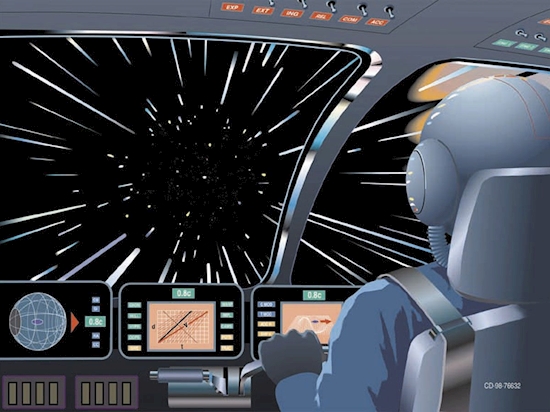Is There Any Real Science Behind Trek?
Star Trek is one of the most popular science fiction series of all time and loved by people around the world. In its TV shows, movies, novels, comics, and podcasts, future inhabitants of Earth go on quests to the far reaches of the Milky Way Galaxy. They travel across space using advanced technologies like warp drive propulsion systems and artificial gravity. Along the way, the Star Trek denizens explore strange new worlds. The science and technology in Star Trek are dazzling and lead many fans to ask: could such propulsion systems and other technological advances exist now or in the future?
In a few cases, the science is actually quite sound and we either have the technology now (such as the first rudimentary medical tricorders and communications devices) or someone will be developing it sometime in the near future. Other technologies in the Star Trek universe are sometimes in agreement with our understanding of physics—such as the warp drive—but are highly improbable to ever exist. For those, we might have to wait until our technology abilities catch up to theory. Still Trek ideas are more in the realm of imagination and don't stand a chance of ever becoming a reality.
Impulse Drive: The impulse drive is not unlike our chemical rockets of today, only more advanced. With advances taking place today, it is not unreasonable to think that we will one day have propulsion systems similar to the impulse drive on the starship Enterprise.
Cloaking Devices: The irony here, of course, is that this is a technology that humans have yet to grasp in the early Star Trek series (although the Klingon Empire has it). Yet this is one of the technologies that is closest to becoming a reality today. There are devices that cloak small objects up to the size of people, but making an entire spaceship disappear is still quite a ways away.
Communication Devices: In Star Trek, no one goes anywhere without one. All members of Starfleet carried with them a device that allowed them to communicate with other members of the crew. In reality, many people don't go anywhere without their smartphones, and there are even working comm badges.
Tricorder-like Devices: In Star Trek, portable sensors are used "in the field" for everything from medical diagnoses to rock and atmospheric sampling. Today's spacecraft on Mars and beyond use such sensors, although not quite yet "portable". In recent years, teams of inventors have created working medical tricorder-like machines that are already making their way into the market.
Time Travel: Time travel into the past or the future is not in strict violation of the laws of physics. However, the amount of energy needed to accomplish such a feat takes the practicality of it out of reach.
Wormholes: A wormhole is a theoretical construct of general relativity that, under certain circumstances can be created in places like black holes. The main problem is that passing through (or even approaching) a wormhole created by such objects would be potentially deadly. The alternative is to create a wormhole in a location of your choosing, but this would require the presence of exotic matter that isn't known to exist in large quantities and would require so much energy that it is not likely we could ever achieve it. So while wormholes may very well exist, it seems highly improbable that we would ever be able to travel through one.
Warp Drive: Like wormholes, warp drive does not violate any laws of physics. However, it too would require such immense amounts of energy and exotic matter that it seems improbable that developing such technology will ever be possible.
Energy Shields and Tractor Beams: These technologies are linchpins to the Star Trek series. We could someday have technologies that have a similar effect as those used in the films. However, they will likely work in a much different manner.
Matter-antimatter Power: The starship Enterprise famously uses a matter-antimatter reaction chamber to create the energy used to power the ship. While the principle behind this power plant is sound, the problem is creating enough antimatter to make it practical. As of today, it is extremely unlikely that we will ever obtain enough antimatter to justify making such a device.
Edited and updated by Carolyn Collins Petersen.
Source: www.thoughtco.com

